





There are a lot of things one can do at the beach - swimming, fishing, surfing, kite flying, walking, beachcombing, bird watching, sun bathing, jogging, tidepooling, kayaking, botanizing... Botanizing? Yes, identifying, observing, and examining plants at the beach can add to your day of fun.
If you have ever taken much note of the plants at the beach, you may have noticed that many of them are not found further inland, or that many inland plants are not found at the beach. This is mainly because of salt. Salt makes it more difficult for plants to take in the water they need. (See DG article Seaside Plants) Even plants far above the high tide line are still subjected to salt in the air, which then deposits on everything, as a look at your car windshield at the end of the day will show.
For plants, the beach is much like the desert, so seaside plants often have the same survival strategies as desert plants. Until I realized this, it was strange to me to see plants like bladderpod (Isomeris arborea) and Mojave yucca (Yucca schidigera) in the inland Mojave Desert and at the beach, but not in between. The survival strategies of beach and desert plants include succulence and foliage that resists evaporation. This foliage that resists evaporation is often grayish or bluish due to waxes that directly help seal against excessive evaporation, or due to hairs that shade the leaves. Do not be surprised to find cacti at the beach. For example, you may find Opuntia humifusa on the east coast of the United States and Opuntia littoralis and others in southern California.
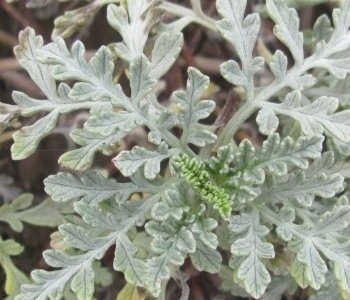
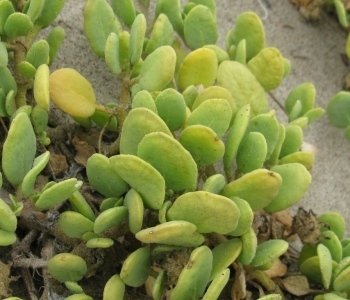
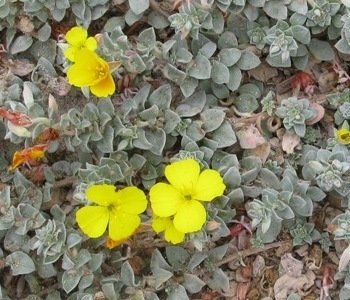
Beach-bur (Ambrosia chamissonis) is a low-growing plant with finely-cut, gray foliage - Leo Carrillo State Park
Beach pancake (Abronia maritima) is a low-growing plant with small, succulent leaves - Leo Carrillo State Park
Beach primrose (Camissonia cheiranthifolia) is a low-growing plant with small, gray leaves - Emma Wood State Beach
Another thing that beach plants have to deal with is the wind. There is nothing to shield them from storms coming right in from the ocean. Therefore, many plants at the beach tend to be low-growing and have small or finely cut leaves. This helps to minimize destructive wind resistance.
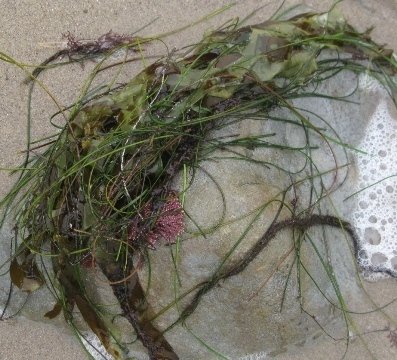
An assortment of "seaweeds" - Leo Carrillo State Park
Besides the terrestrial plants, depending on your location, you may also encounter water plants, familiarly called "seaweed". Surf grass (Phyllospadix ssp.) is a flowering plant, but most seaweeds are algae. Smaller species can be seen at low tide growing in tidepools. Beds of the larger kelps may be visited by kayakers or divers, but long strands of kelp can be found washed up on the beach. Go ahead and examine them. Kelp feels like plastic. Notice how flexible and strong the plants are. This keeps them from being broken by the waves and surge, at least under normal weather conditions.
Perhaps you go to an urban beach. You can still find plants. There might be landscaping in the parking lot, around the hotels, or at beachside condos. Since the climate along the ocean is usually more temperate than inland, you may find different plants being used right at the shore than you would find inland. Of course the salt-tolerant requirement still applies. Summer annuals being used in beachside landscaping are likely to be pretty rugged and you might find them to be just the thing to use in troublesome dry areas at home.
Plants can even be the highlight of a trip to the beach, especially for those in the know. Perhaps you will get to see rare conifers like Torrey pines (Pinus torreyana) or Monterey cypress (Cupressus macrocarpa) or endangered Hawaiian flora in its natural habitat. Learn about the place ahead of time and be on the lookout for special plants.
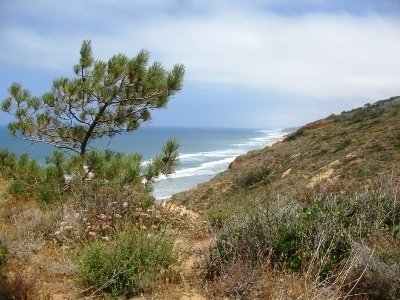 Torrey Pines State Reserve is a treat for anyone interested in wild plants
Torrey Pines State Reserve is a treat for anyone interested in wild plants
Perhaps you are curious to know the names of beach plants. A field guide to the relevant area should cover the wild terrestrial plants. You may need a field guide to tidepool or marine life in order to identify the seaweeds. I think it is very helpful to study a little before you go. In this Internet era, it is easy to find on-line information or purchase books pertaining to places all over the world. Once at the beach or park, you may find a visitor center or museum with more information. Identifying landscaping plants may be more of a challenge. The Dave's Garden Plant and Tree Identification forum can be helpful here. Take pictures of flowers, leaves, and any other details that might be of interest. A picture of the whole plant would not hurt, either. Of course you can still enjoy the plants and never know or even care what their names are. I like identifying plants, but if you find it difficult, then skip it. After all, a day at the beach is for fun, not work.
If you enjoying looking at plants in the fields and forests, take the habit with you to the beach. If jellyfish or rip tides keep you out of the water or you just feel like taking a walk, spend some time looking at the plants.
Copyright © www.100flowers.win Botanic Garden All Rights Reserved